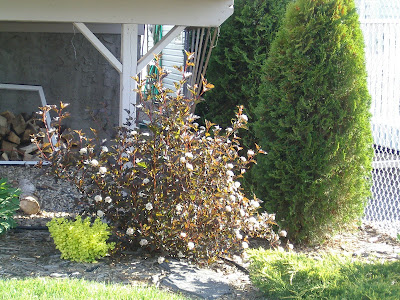Galahad Mock Orange
MOCK ORANGE SHRUB (PHILADELPHUS)
If only a picture could capture the fragrance of a Mock Orange in bloom! The flowers are similar to that of an orange or lemon tree and the fragrance like an orange or, as one of my children said, cotton candy. In our area, the mock orange blooms June/July. It is lovely to sit out in the yard on a warm summer evening and catch a whiff of fragrance of mock orange in the night. The white blossoms glow in the twilight, reflecting whatever light is nearby. Truly one shrub I do not want to be without.
There are several varieties of Philadelphus (mock orange) hardy for our area, zone 3. Waterton, Minnesota Snowflake, Galahad, Golden, Miniature Snowflake, to name a few. I purchased Galahad about 3-4 years ago and wish I had more.
Though unimpressive the remainder of the season, when in bloom it draws compliments from everyone! The Galahad grows about 4 feet tall and wide. I don't fertilize, though one could give it a dose with rose fertilizer early spring. Prune only after it has completed flowering, and directly afterwards not late summer or fall and definitely not early spring or it will not bloom!
The fragrance varies by variety, so shop for them while they are in bloom. The flowers range by variety from single, like the Galahad, to semi-double to fully double from an inch to 2 inches across on some varieties.
Galahad Mock Orange
USES IN THE LANDSCAPE
Mock orange may be grown as a specimen plant, a focus in the border; as a foundation shrub; or grow a grouping as a hedge. It tends to grow somewhat vase-shaped, but clipping can encourage the plant to fill out and become dense.
LOCATION FOR PLANTING
This plant does well in full sun or even part sun and shade. Some have had luck growing it in a rather shady location. Avoid planting near a reflective surface or white siding or fence where the sun will reflect onto the foliage and flowers and fade them quickly. The mock orange prefers a well-drained soil, but isn't too particular about the type of soil. However, a sandy loam type soil that is well-drained would be ideal. The mock orange is an easy care plant. Not demanding too much attention, except to exclaim over its beauty and fragrance!
PRUNING
Prune only after flowering. After its second year in your garden, you may desire to remove some of the older branches which no longer produce blooms. Remember the rule of thumb, never more than 1/3 of the overall plant should be pruned in a year.


















































